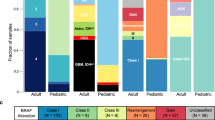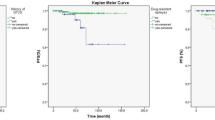Abstract
Pediatric brain tumors are highly associated with epileptic seizures1. However, their epileptogenic mechanisms remain unclear. Here, we show that the oncogenic BRAF somatic mutation p.Val600Glu (V600E) in developing neurons underlies intrinsic epileptogenicity in ganglioglioma, one of the leading causes of intractable epilepsy2. To do so, we developed a mouse model harboring the BRAFV600E somatic mutation during early brain development to reflect the most frequent mutation, as well as the origin and timing thereof. Therein, the BRAFV600E mutation arising in progenitor cells during brain development led to the acquisition of intrinsic epileptogenic properties in neuronal lineage cells, whereas tumorigenic properties were attributed to high proliferation of glial lineage cells. RNA sequencing analysis of patient brain tissues with the mutation revealed that BRAFV600E-induced epileptogenesis is mediated by RE1-silencing transcription factor (REST), which is a regulator of ion channels and neurotransmitter receptors associated with epilepsy. Moreover, we found that seizures in mice were significantly alleviated by an FDA-approved BRAFV600E inhibitor, vemurafenib, as well as various genetic inhibitions of Rest. Accordingly, this study provides direct evidence of a BRAF somatic mutation contributing to the intrinsic epileptogenicity in pediatric brain tumors and suggests that BRAF and REST could be treatment targets for intractable epilepsy.
This is a preview of subscription content, access via your institution
Access options
Access Nature and 54 other Nature Portfolio journals
Get Nature+, our best-value online-access subscription
$29.99 / 30 days
cancel any time
Subscribe to this journal
Receive 12 print issues and online access
$209.00 per year
only $17.42 per issue
Buy this article
- Purchase on Springer Link
- Instant access to full article PDF
Prices may be subject to local taxes which are calculated during checkout




Similar content being viewed by others
Data availability
We deposited the whole-exome sequencing data reporting variants in each individual and RNA sequencing data reporting the tumor-specific transcriptome in the BioProject repository under accession numbers PRJNA481075 and PRJNA480934, respectively.
References
van Breemen, M. S., Wilms, E. B. & Vecht, C. J. Epilepsy in patients with brain tumours: epidemiology, mechanisms, and management. Lancet Neurol. 6, 421–430 (2007).
Thom, M., Blumcke, I. & Aronica, E. Long-term epilepsy-associated tumors. Brain Pathol. 22, 350–379 (2012).
Blumcke, I. et al. Low-grade epilepsy-associated neuroepithelial tumours—the 2016 WHO classification. Nat. Rev. Neurol. 12, 732–740 (2016).
Kerkhof, M. & Vecht, C. J. Seizure characteristics and prognostic factors of gliomas. Epilepsia 54, 12–17 (2013).
Aronica, E. et al. Differential expression patterns of chloride transporters, Na+–K+–2Cl–-cotransporter and K+–Cl–-cotransporter, in epilepsy-associated malformations of cortical development. Neuroscience 145, 185–196 (2007).
Aronica, E. et al. Expression and localization of voltage dependent potassium channel Kv4.2 in epilepsy associated focal lesions. Neurobiol. Dis. 36, 81–95 (2009).
Lim, J. S. et al. Brain somatic mutations in MTOR cause focal cortical dysplasia type II leading to intractable epilepsy. Nat. Med. 21, 395–400 (2015).
Lim, J. S. et al. Somatic mutations in TSC1 and TSC2 cause focal cortical dysplasia. Am. J. Hum. Genet. 100, 454–472 (2017).
Yuan, T. L. & Cantley, L. C. PI3K pathway alterations in cancer: variations on a theme. Oncogene 27, 5497–5510 (2008).
Hardt, M., Chantaravisoot, N. & Tamanoi, F. Activating mutations of TOR (target of rapamycin). Genes Cells 16, 141–151 (2011).
Zhang, J. et al. Whole-genome sequencing identifies genetic alterations in pediatric low-grade gliomas. Nat. Genet. 45, 602–612 (2013).
Blumcke, I. & Wiestler, O. D. Gangliogliomas: an intriguing tumor entity associated with focal epilepsies. J. Neuropathol. Exp. Neurol. 61, 575–584 (2002).
Semple, B. D., Blomgren, K., Gimlin, K., Ferriero, D. M. & Noble-Haeusslein, L. J. Brain development in rodents and humans: identifying benchmarks of maturation and vulnerability to injury across species. Prog. Neurobiol. 106–107, 1–16 (2013).
Sauvageot, C. M. & Stiles, C. D. Molecular mechanisms controlling cortical gliogenesis. Curr. Opin. Neurobiol. 12, 244–249 (2002).
Aridon, P. et al. Increased sensitivity of the neuronal nicotinic receptor alpha 2 subunit causes familial epilepsy with nocturnal wandering and ictal fear. Am. J. Hum. Genet. 79, 342–350 (2006).
Srivastava, S. et al. A novel variant in GABRB2 associated with intellectual disability and epilepsy. Am. J. Med. Genet. A 164A, 2914–2921 (2014).
Cossette, P. et al. Mutation of GABRA1 in an autosomal dominant form of juvenile myoclonic epilepsy. Nat. Genet. 31, 184–189 (2002).
Dibbens, L. M. et al. GABRD encoding a protein for extra- or peri-synaptic GABAA receptors is a susceptibility locus for generalized epilepsies. Hum. Mol. Genet. 13, 1315–1319 (2004).
Wallace, R. H. et al. Mutant GABAA receptor γ2-subunit in childhood absence epilepsy and febrile seizures. Nat. Genet. 28, 49–52 (2001).
Lemke, J. R. et al. GRIN2B mutations in West syndrome and intellectual disability with focal epilepsy. Ann. Neurol. 75, 147–154 (2014).
Goldberg, E. M. & Coulter, D. A. Mechanisms of epileptogenesis: a convergence on neural circuit dysfunction. Nat. Rev. Neurosci. 14, 337–349 (2013).
McClelland, S. et al. The transcription factor NRSF contributes to epileptogenesis by selective repression of a subset of target genes. eLife 3, e01267 (2014).
Samadani, U., Judkins, A. R., Akpalu, A., Aronica, E. & Crino, P. B. Differential cellular gene expression in ganglioglioma. Epilepsia 48, 646–653 (2007).
Mittapalli, R. K., Vaidhyanathan, S., Sane, R. & Elmquist, W. F. Impact of P-glycoprotein (ABCB1) and breast cancer resistance protein (ABCG2) on the brain distribution of a novel BRAF inhibitor: vemurafenib (PLX4032). J. Pharmacol. Exp. Ther. 342, 33–40 (2012).
Sakji-Dupre, L. et al. Cerebrospinal fluid concentrations of vemurafenib in patients treated for brain metastatic BRAF-V600 mutated melanoma. Melanoma Res. 25, 302–305 (2015).
Noh, K. M. et al. Repressor element-1 silencing transcription factor (REST)-dependent epigenetic remodeling is critical to ischemia-induced neuronal death. Proc. Natl Acad. Sci. USA 109, E962–E971 (2012).
Ballas, N. et al. Regulation of neuronal traits by a novel transcriptional complex. Neuron 31, 353–365 (2001).
McClelland, S. et al. Neuron-restrictive silencer factor-mediated hyperpolarization-activated cyclic nucleotide gated channelopathy in experimental temporal lobe epilepsy. Ann. Neurol. 70, 454–464 (2011).
Aronica, E. et al. Inhibitory networks in epilepsy-associated gangliogliomas and in the perilesional epileptic cortex. Epilepsy Res. 74, 33–44 (2007).
Zurolo, E. et al. Activation of Toll-like receptor, RAGE and HMGB1 signalling in malformations of cortical development. Brain 134, 1015–1032 (2011).
Nadeau, H. & Lester, H. A. NRSF causes cAMP-sensitive suppression of sodium current in cultured hippocampal neurons. J. Neurophysiol. 88, 409–421 (2002).
Nava, C. et al. De novo mutations in HCN1 cause early infantile epileptic encephalopathy. Nat. Genet. 46, 640–645 (2014).
Endele, S. et al. Mutations in GRIN2A and GRIN2B encoding regulatory subunits of NMDA receptors cause variable neurodevelopmental phenotypes. Nat. Genet. 42, 1021–1026 (2010).
Stodberg, T. et al. Mutations in SLC12A5 in epilepsy of infancy with migrating focal seizures. Nat. Commun. 6, 8038 (2015).
Epi4K Consortium. Epi4K: Gene discovery in 4,000 genomes. Epilepsia 53, 1457–1467 (2012).
Louis, D. N. et al. The 2016 World Health Organization Classification of Tumors of the Central Nervous System: a summary. Acta Neuropathol. 131, 803–820 (2016).
Park, Y. S., Kim, D. S., Shim, K. W., Kim, J. H. & Choi, J. U. Factors contributing to resectability and seizure outcomes in 44 patients with ganglioglioma. Clin. Neurol. Neurosurg. 110, 667–673 (2008).
Cingolani, P. et al. A program for annotating and predicting the effects of single nucleotide polymorphisms, SnpEff: SNPs in the genome of Drosophila melanogaster strainw1118; iso-2; iso-3. Fly (Austin) 6, 80–92 (2012).
Mercer, K. et al. Expression of endogenous oncogenic V600EB-raf induces proliferation and developmental defects in mice and transformation of primary fibroblasts. Cancer Res. 65, 11493–11500 (2005).
Dhomen, N. et al. Oncogenic Braf induces melanocyte senescence and melanoma in mice. Cancer Cell. 15, 294–303 (2009).
Beaudoin, G. M. 3rd et al. Culturing pyramidal neurons from the early postnatal mouse hippocampus and cortex. Nat. Protoc. 7, 1741–1754 (2012).
Royer, S. et al. Control of timing, rate and bursts of hippocampal place cells by dendritic and somatic inhibition. Nat. Neurosci. 15, 769–775 (2012).
Vajda, I. et al. Low-frequency stimulation induces stable transitions in stereotypical activity in cortical networks. Biophys. J. 94, 5028–5039 (2008).
Odawara, A., Katoh, H., Matsuda, N. & Suzuki, I. Physiological maturation and drug responses of human induced pluripotent stem cell-derived cortical neuronal networks in long-term culture. Sci. Rep. 6, 26181 (2016).
Trapnell, C. et al. Differential gene and transcript expression analysis of RNA-seq experiments with TopHat and Cufflinks. Nat. Protoc. 7, 562–578 (2012).
Trapnell, C. et al. Transcript assembly and quantification by RNA-seq reveals unannotated transcripts and isoform switching during cell differentiation. Nat. Biotechnol. 28, 511–515 (2010).
Spurlock, C. F. 3rd et al. Expression and functions of long noncoding RNAs during human T helper cell differentiation. Nat. Commun. 6, 6932 (2015).
Mei, Y. et al. Adult restoration of Shank3 expression rescues selective autistic-like phenotypes. Nature 530, 481–484 (2016).
Perucca, E. The management of refractory idiopathic epilepsies. Epilepsia 42, 31–35 (2001).
Kim, S. K. et al. Human histone H3K79 methyltransferase DOT1L protein [corrected] binds actively transcribing RNA polymerase II to regulate gene expression. J. Biol. Chem. 287, 39698–39709 (2012).
Acknowledgements
We thank K. S. Kim at the School of Medicine in Chungnam National University for breeding the Braflsl-V637E/+ mice, G. Mandel at Howard Hughes Medical Institute in Oregon Health and Science University for providing plasmid DNA of dnREST, and S. M. Park and W. K. Kim at the Korea Advanced Institute of Science and Technology (KAIST) for coordinating the clinical information. This work was supported by the Suh Kyungbae Foundation (to J.H.L.) and grants from the Citizens United for Research in Epilepsy (to J.H.L.) and the Korean Health Technology Research and Development (R&D) Project, Ministry of Health & Welfare, Republic of Korea (H15C3143 to J.H.L. and H16C0415 to D.S.K. and J.H.L.), KAIST (G04170025 to J.H.) and IBS-R002-D1 (to J.H.L).
Author information
Authors and Affiliations
Contributions
H.Y.K. organized the project and performed the genetic studies and the bioinformatics analysis with J.S.L. S.H.K. and J.C. performed the pathological studies. H.Y.K. performed the immunostaining, the biochemical in vitro work and in vivo studies with M.S. The in vivo chromatin immunoprecipitation assay was done by S.H. and H.Y.K. with D.L. Electrical signaling using multielectrodes in brain slices was recorded by H.Y.K. and analyzed by J.J. and S.-B.P. H.Y.K. performed the in vivo single-unit recording with H.K. and H.J.L. H.Y.K. performed the video EEG recording and the analysis of seizures. G.S., B.O.P., W.D.H. and J.H. prepared the viral constructs. D.S.K. performed the surgeries, collected patient samples and managed patient information and tissues samples with S.H.K. and H.-C.K. H.Y.K. and J.H.L. led the project and oversaw the manuscript preparation.
Corresponding author
Ethics declarations
Competing interests
The authors declare no competing interests.
Additional information
Publisher’s note Springer Nature remains neutral with regard to jurisdictional claims in published maps and institutional affiliations.
Supplementary Information
Supplementary Text and Figures
Supplementary Figures 1–9 and Supplementary Tables 1–7
Supplementary Video 1
Video-EEG monitoring of wildtype Braf (left) or somatic Braf V637E mutation carrying (right) mice
Rights and permissions
About this article
Cite this article
Koh, H.Y., Kim, S.H., Jang, J. et al. BRAF somatic mutation contributes to intrinsic epileptogenicity in pediatric brain tumors. Nat Med 24, 1662–1668 (2018). https://doi.org/10.1038/s41591-018-0172-x
Received:
Accepted:
Published:
Issue Date:
DOI: https://doi.org/10.1038/s41591-018-0172-x
This article is cited by
-
Germline BRCA2 pathogenic variants in pediatric ganglioglioma: Case report and review of the literature
Child's Nervous System (2024)
-
Co-dependent regulation of p-BRAF and potassium channel KCNMA1 levels drives glioma progression
Cellular and Molecular Life Sciences (2023)
-
Ganglioglioma with adverse clinical outcome and atypical histopathological features were defined by alterations in PTPN11/KRAS/NF1 and other RAS-/MAP-Kinase pathway genes
Acta Neuropathologica (2023)
-
GABAA receptor function is enhanced by Interleukin-10 in human epileptogenic gangliogliomas and its effect is counteracted by Interleukin-1β
Scientific Reports (2022)
-
The clinical and pathological features of low-grade epilepsy-associated glioneuronal tumors
Scientific Reports (2022)



